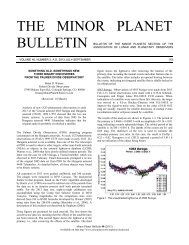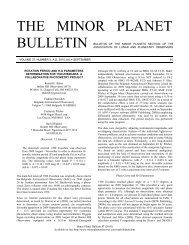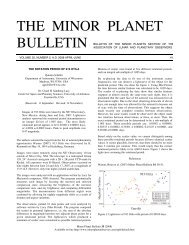THE MINOR PLANET BULLETIN - MinorPlanet.Info
THE MINOR PLANET BULLETIN - MinorPlanet.Info
THE MINOR PLANET BULLETIN - MinorPlanet.Info
- No tags were found...
You also want an ePaper? Increase the reach of your titles
YUMPU automatically turns print PDFs into web optimized ePapers that Google loves.
109<br />
ASTEROID LIGHTCURVE ANALYSIS AT<br />
<strong>THE</strong> PALMER DIVIDE OBSERVATORY:<br />
2008 DECEMBER – 2009 MARCH<br />
Brian D. Warner<br />
Palmer Divide Observatory/Space Science Institute<br />
17995 Bakers Farm Rd., Colorado Springs, CO 80908 USA<br />
brian@<strong>MinorPlanet</strong>Observer.com<br />
(Received: 2009 Mar 24 Revised: 2009 Apr 9)<br />
Lightcurves for 34 asteroids were obtained at the Palmer<br />
Divide Observatory from 2008 December through 2009<br />
March: 91 Aegina, 261 Prymno, 359 Georgia,<br />
402 Chloe, 497 Iva, 506 Marion, 660 Crescentia,<br />
691 Lehigh, 731 Sorga, 779 Nina, 802 Epyaxa,<br />
908 Buda, 1015 Christa, 1518 Rovaniemi,<br />
1600 Vyssotsky, 1656 Suomi, 2000 Herschel,<br />
2735 Ellen, 3169 Ostro, 3854 George, 3940 Larion,<br />
(5558) 1989 WL 2 , (5747) 1991 CO 3 , 6517 Buzzi,<br />
(11304) 1993 DJ, (22195) 3509 P-L, (26383) 1999<br />
MA 2 , (29780) 1999 CJ 50 , (45878) 2000 WX 29 ,<br />
(45898) 2000 XQ 49 , (76800) 2000 OQ 35 , (76929)<br />
2001 AX 34 , (87343) 2000 QH 25 , and (207398) 2006<br />
AS 2 .<br />
approximate Cousins R magnitudes based on 2MASS J-K colors<br />
(see Warner 2007b and Stephens 2008).<br />
91 Aegina. The period of 6.030 h found here agrees with those<br />
found by Harris (1980) and Shevchenko (1997) although the<br />
amplitude of 0.27 mag found here is nearly double of any previous<br />
results.<br />
261 Prymno. The period of 8.007 h agrees with the 8.002 h found<br />
by Harris (1989).<br />
359 Georgia. Previous periods of 7.3 h (Lagerkvist, 1978) and<br />
13.25 (Gil-Hutton, 1995) do not agree with the period of 5.537 h<br />
found here and 5.5334 h by Behrend (2009).<br />
402 Chloe. Since at least two, significantly different periods had<br />
been previously reported: 9.765 h (Wetter, 1998) and 7.11 h<br />
(Denchev, 2000; Behrend, 2009), this asteroid was observed to see<br />
if it was possible to find a definitive period. Based on four nights<br />
in 2009 February, a period of 10.664 h was found. The PDO data<br />
do not fit the previously reported periods.<br />
497 Iva. This asteroid was observed to resolve the discrepancy<br />
between the periods found by Harris (1983, 4.62 h) and Behrend<br />
(2009, 4.42 h). Data obtained on 2009 Jan 9-11 found a period of<br />
4.621 h, confirming the period found by Harris.<br />
Observations of 34 asteroids were made at the Palmer Divide<br />
Observatory (PDO) from 2008 December through 2009 March.<br />
One of four telescope/camera combinations was used: 0.5m<br />
Ritchey-Chretien/SBIG STL-1001E, 0.35m SCT/FLI IMG-1001E,<br />
0.35m SCT/ST-9E, or 0.35m SCT/STL-1001E. All images were<br />
1x1 binning, resulting in a scale of approximately 1.2 arcseconds<br />
per pixel. All exposures were guided and from 30-240 s. Most<br />
observations were made with no filter but, for example, when a<br />
nearly full moon was present, a Cousins R or SDSS r´ filter was<br />
used to decrease the sky background. All images were processed<br />
and measured using MPO Canopus employing differential<br />
aperture photometry. Period analysis was also done using MPO<br />
Canopus, which incorporates the Fourier analysis algorithm<br />
developed by Harris (Harris et al., 1989).<br />
The results are summarized in the table below, as are individual<br />
plots. The data and curves are presented without comment except<br />
when warranted. An “(H)” follows the name of an asteroid in the<br />
table if it is a member of the Hungaria group/family, which is a<br />
primary target of the PDO observing program. The plots are<br />
“phased”, i.e., they range from 0.0 to 1.0 of the stated period.<br />
Most of the plots are scaled such that 0.8 mag has the same linear<br />
size as the horizontal axis from 0.0 to 1.0. This is done to allow<br />
direct comparison of amplitudes and to avoid the visual<br />
impression that the amplitude of variation is greater than it<br />
actually is, which can create the impression of a physically<br />
implausible lightcurve. There are some cases where the scale has<br />
been modified, those being mostly for low amplitude lightcurves,<br />
where the above scaling would have resulted in a nearly flat plot.<br />
Even so, the vertical scale has been expanded as little as possible<br />
to avoid creating misleading interpretations.<br />
Many of the asteroids here were observed to resolve discrepancies<br />
among previous results and/or to provide additional data for shape<br />
and spin axis modeling. A number of the asteroids were found to<br />
have long periods. In these cases, night-to-night calibration of the<br />
data became critical. This was done using field stars converted to<br />
Minor Planet Bulletin 36 (2009)<br />
506 Marion. Robinson and Warner (2002) reported a period of<br />
10.58 h, Gil-Hutton and Canada (2003) found 18.505 h, while<br />
Behrend (2009) reported one of 13.546 h. The new PDO data<br />
confirm Behrend’s period, finding 13.538 h based on four sessions<br />
in 2009 February.<br />
660 Crescentia. This asteroid was observed to resolve the<br />
discrepancy between Harris (1980, 7.92 h) and Behrend (2009, 9.1<br />
h). The Harris result was confirmed, with the new data finding a<br />
period of 7.910 h.<br />
691 Lehigh. Previously reported periods were: 5.08 h (Stephens,<br />
2000), 10.482 h (Menke, 2005), and 12.86 h (Behrend, 2009). The<br />
PDO found a period of 12.891 h, confirming the Behrend solution.<br />
A solution of 14.502 h was also found but the fit of the data was<br />
not nearly as good.<br />
731 Sorga. This was follow up to previous work (Warner 2005)<br />
which found P = 8.184 h, A = 0.52 mag. The new data found P =<br />
8.192 h, A = 0.19 mag.<br />
779 Nina. The result of P = 11.17 h agrees with P = 11.186 h<br />
found by Harris et al. (1992).<br />
908 Buda. Binzel (1987) reported P = 18.20 h and Behrend (2009)<br />
P = 14.575 h. The PDO result was P = 14.572 h.<br />
1015 Christa. Behrend (2009) found P = 12.189 h, based on three<br />
sessions with gaps of one week to one month between successive<br />
sessions. The PDO data, four sessions of which were on<br />
consecutive nights, support P = 11.230 and do not fit the longer<br />
period.<br />
1518 Rovaniemi. The period of P = 5.249 h agrees with Behrend<br />
(2009).<br />
1600 Vyssotsky. The author has worked this asteroid several times<br />
in the past (Warner, 1999, 2006a, 2008). It was worked in 2009<br />
with the hope of improving the shape model reported by Warner et










